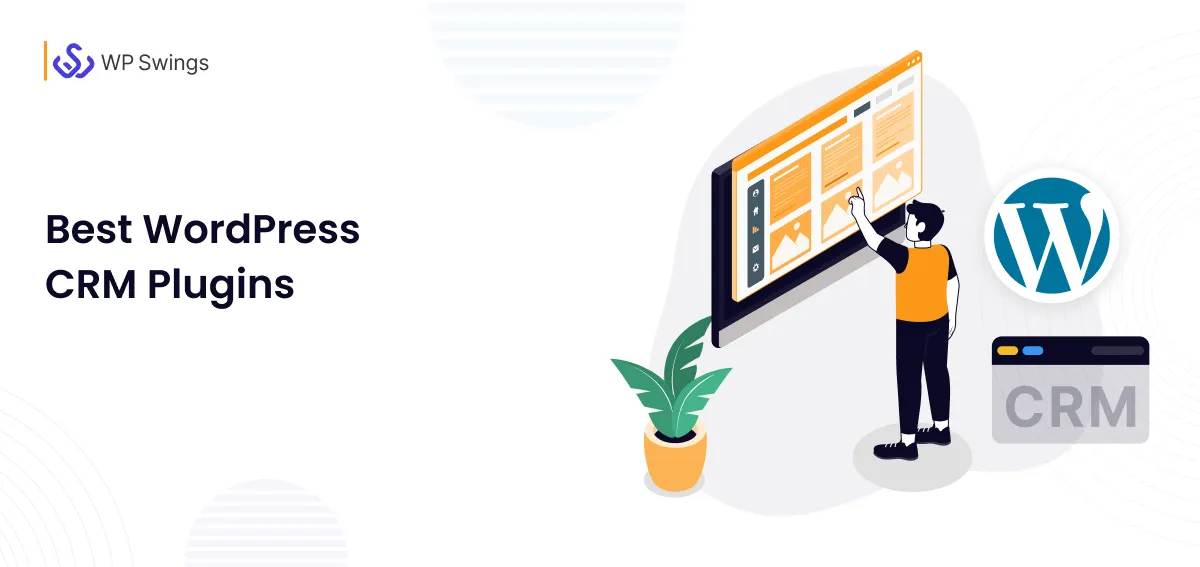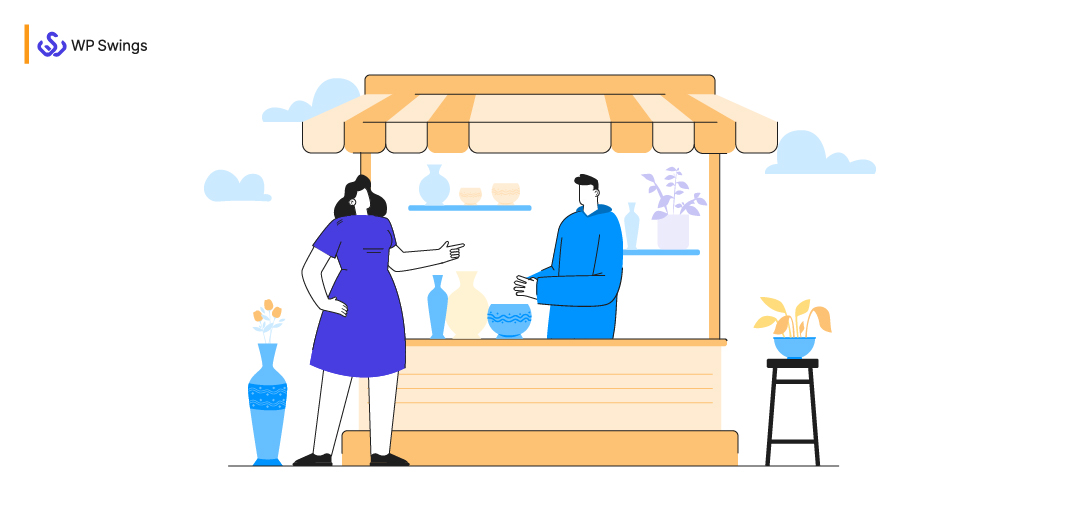
Sell crafts online, and only make what you’ve been paid for! – Jes Van Den
Selling crafts online would be a great idea if you are an artist who drives our artistic growth by creating them. Sell crafts online and You can make a lot of money and it will also help you to keep our ancestors’ crafts alive.
In ancient times, people used to live in small groups and they used to make all of the utility items that their group required. Handmade crafts are known as handicrafts, and their products are known as handicraft goods.
Therefore, handicraft was gradually replaced by machines during the industrial revolution. No machine, however, can ever replicate the level of detail and art created by the human hand. As a result, handicrafts continue to be popular among the general public. They are not only appreciated but also highly valued.
In this article, we will show you how to sell crafts online by creating a website and how to sell handcrafted items online using a WordPress website. If you’re still unsure whether you should open a handicraft shop online, keep reading to learn about more reasons to set up a website for selling handicraft items online.
From Surviving to Thriving: Covid19 Impact on Crafts Business
In March 2020, the World Health Organisation (WHO) declared Covid-19 as a pandemic. Many countries took strict measures to limit international travel. While this worked to slow down the infection rate, it precipitated a global economic recession.
With great economic uncertainty, many people lost their jobs, demand dropped, supply chains were disrupted and many daily wage workers in India faced a stark choice which was the greater risk to their lives and livelihoods-Covid-19 or lack of economic opportunities to support their families.
Some Governments supported basic necessities and food security while contending with hugely increased pressure on healthcare resources. Private institutions, civil society NGOs, and individuals joined forces in providing relief to the most vulnerable communities.
According to initial estimations by the Export Promotion Council for Handicrafts (EPCH), the handicrafts sector could have suffered a loss of Rs 80-100 billion post-pandemic. Several months after the lockdown restrictions were revoked, many arts and culture sectors continue to struggle to remain resilient from the impact of Covid-19 and the lockdown.
India’s craft sector, the second largest employer in India (after agriculture) with over 200 million artisans, has experienced dramatic changes because of the pandemic.
Consumption dropped, orders were canceled, payments were pending, traditional supply chains broke down, unsold stocks accumulated, offline modes of selling products (exhibitions and fairs) stopped, and craft organizations’ financial reserves were drawn-down in order to survive. In some instances, crafts clusters relied on State Government intervention for micro-grants and food.
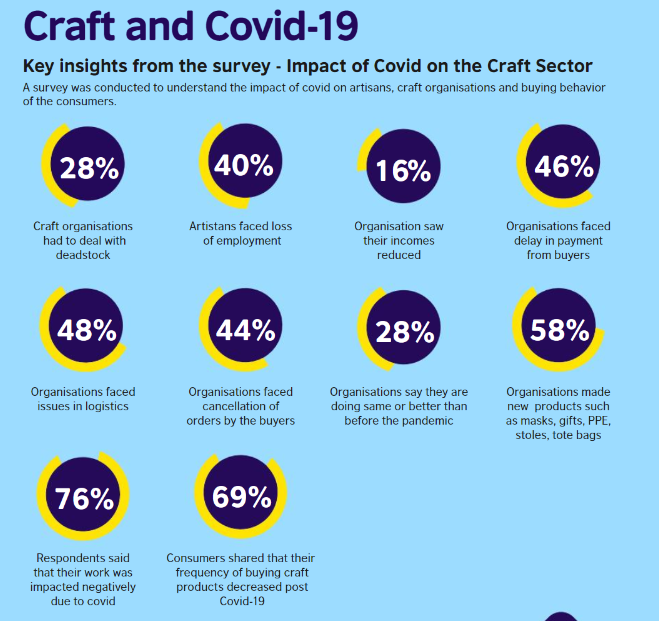
Source: issuu
01. Craft Sector Recognition

This sector should be recognized as a crucial sector on similar lines to agriculture, textile, and retail amongst others. A national action plan and systematic support should be mobilized to strengthen the craft economy as this sector is one of the largest employment generators around the globe after agriculture.
02. Lives and Livelihoods
When the pandemic broke out, the most vulnerable artisans were faced with a dilemma on what was more dangerous for their lives – the novel coronavirus or not having economic opportunities to support livelihoods.
03. Collaborative Ecosystem
The craft sector was working in silos pre-Covid. There was a shift in the nature of the support network that evolved during the pandemic which will be the defining foundation for the partnerships that will be forged in the next chapter of the craft ecosystem.
04. The Future is Digital
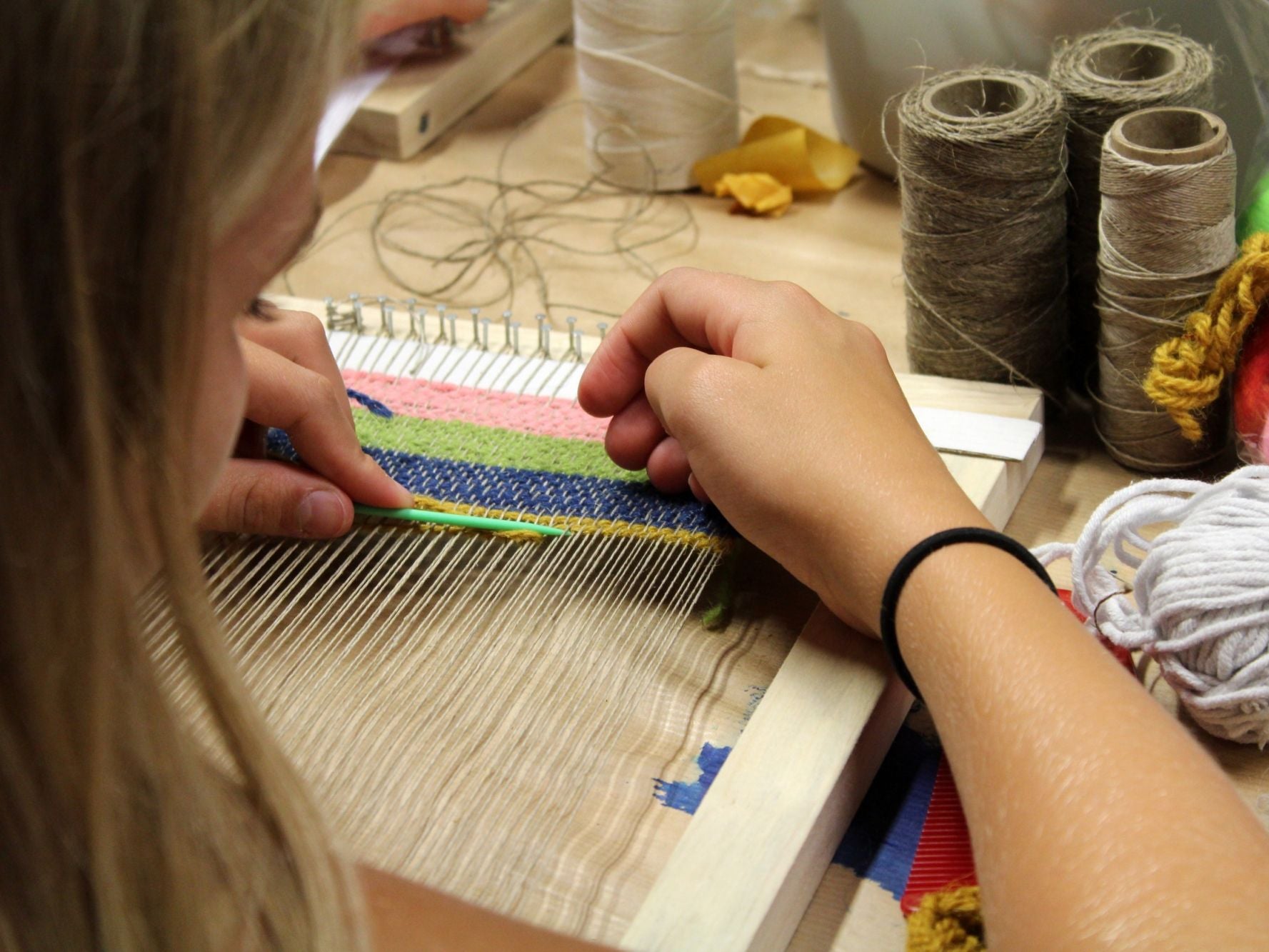
The power of technology, social media, and e-commerce websites was leveraged during the pandemic to enable artisans and craft organizations to reach out to consumers and sell products
05. Rethinking the Supply Chain
Covid-19 disrupted the conventional supply chains and highlighted the fractures in the existing systems of procurement of raw materials, resource allocation, and logistics. There is a need to move from long supply chains to shorter supply chains to enable circularity and sustainability.
06. Artisans First Building Capacity and Resilience
Through the crisis, it is evident that the solutions in the craft sector need to keep the artisans at the center. The key to building long-term resilience in the sector is through strengthening the artisan communities.
07. Product Innovation and Design
It is said that ‘necessity is the mother of invention’ and covid has forced organizations to rethink products and design to meet the rapidly changing landscape of consumer behavior, consumption patterns, and new realities.
08. Financial Investment and Support
The craft sector has traditionally been dependent on grants, CSR funds, and Government support to sustain its growth. Considering the potential of this sector to contribute to the national GDP, this sector needs functional partnerships, private sector funds, and structural financial reforms to scale up.
In 2020, the global handicrafts market was expected to be worth USD 417 billion.
Nonetheless, CMH, like many consumer goods market segments hard hit by the pandemic, has a very positive long-term growth outlook. According to a recent report, with over $500 billion in annual revenue last year, the global CMH sector is expected to grow by 20% per year, reaching $1 trillion by 2024.
How WooCommerce Raised the Craft Businesses?
There are currently massive platforms such as BigCommerce, Shopify, Magneto, and others. However, WooCommerce powers 42% of all eCommerce stores worldwide, which is enormous.
As a result, it has become the most popular and dependable platform for establishing Woocommerce for small business startups.
Therefore, WooCommerce is a completely free plugin that you can install after you have set up your WordPress website. It enables you to integrate eCommerce functionality into your WordPress-powered website.
This platform is the most efficient way to grow a craft business into a fully developed eCommerce business. All that remains is to install and activate the plugin, and you’re ready to go!
The majority of WooCommerce’s features are completely free and sufficient to launch your small business.
However, for additional features, you can easily install plugins and run your business effectively. In the beginning, your goal should be to spend as little as possible while earning as much as possible.
Furthermore, as a startup, you need to ensure that you’re on the right track and on solid ground. In reality, you could benefit from WooCommerce’s prominence in the eCommerce world.
Begin with something you believe in but don’t have a specific idea for. Do you have a strong desire to assist small business owners? Do you like working with kids? Are you a car enthusiast who is drawn to other car enthusiasts?
Determine your target audience’s difficulties or demands after you’ve determined who they are. Do they require more comfortable clothing that fits them properly? Are they looking for a way to unwind? Are they looking for opportunities to satisfy people who share their interests?
Choose Products for Your WooCommerce Store
This step must determine what type of product you will sell through your WooCommerce store.
Handmade Products: Your own jewelry, clothing, paper goods, wooden furniture, and cuisine. If you’re clever, want complete control over manufacturing, and want to save money, this is an excellent option.
However, keep in mind that capitalizing on progress may be more difficult because scaling is more difficult when you manufacture every product yourself.
Manufactured Products: Cutlery, footwear, cosmetics, electronics, and car parts are examples of manufactured goods, which are objects created in-house or by a private entity and then kept, sold, and distributed by you.
If you can’t physically make a product or want to expand, this is a great option, but it comes with higher initial costs because you’ll need to order stock ahead of time.
Virtual Products: eBooks, music, online courses, membership programs, and fitness videos are examples of virtual products that are distributed online without the need for a physical format. Virtual products are frequently adaptable and have low setup and ongoing manufacturing costs.
DropShipping WooCommerce Items: T-shirts, wallpapers, and phone accessories are examples of third-party items that are created, collected, and shipped. This method eliminates the hassle of stocking and transporting items, but it also removes some control.
Services provided through the WooCommerce store: These are activities performed for customers without the use of physical resources. Just a few examples include mentoring, advising, graphic design, event planning, hotel reservations, and interior design. These services are available remotely through the WooCommerce store.
We provide expert eCommerce solutions for the number one online selling platform – WooCommerce!
Remember that you can create a specific category and sell it through your WooCommerce store, or you can mix and match different types of products or services.
Create a creative craft store loved by your customers…
Make Your Own Online Handicraft Store
- 100+ beautifully designed themes for creating an online handicraft store
- Using the built-in design tools, you can add a personal touch to your website.
- Adjust the front end to meet your company’s needs.
Increase Sales at Your Handicrafts Shop
- Handicraft display has been improved with product images, zoom, and videos.
- Conversions and quick search with multi-tier categories, faceted search, and so on.
- Built-in discount engine for increased marketing ROI.
M-Commerce allows you to sell more handmade items
- Get your PWA store (which works like a mobile app) for free.
- No coding is required to create iOS and Android apps.
- Sites that load quickly and convert well.
Make Your Handicrafts Company Omnichannel
- Using the decoupled, add new touch points. Architecture for headless commerce.
- Allow commerce to take place through gadgets such as IoT devices, wearables, and so on.
- Sell handcrafted items on eCommerce websites, progressive web apps, mobile apps, and social commerce platforms.
Expand Your Craft Business
- Scalable, always-on eCommerce platform built to support your expansion.
- Make an online store for your B2B or B2C handicraft company.
- Set up a multi-store and multi-vendor handmade items store in minutes.
Take Your Handmade Items To International Markets
- Create a multilingual online store selling handmade items.
- Allow for multi-currency payments to ensure smooth international checkouts.
- Deliver handicrafts all over the world using pre-integrated logistics solutions.
How WooCommerce bridges a gap between handicrafts businesses and customers.
It may appear that the debate over lead quality vs. lead quality is beyond your control. Marketing believes it is attracting the right type of customer, but Sales accuses Marketing of sending ineffective leads. Arguing with each other is pointless, but many people do it, either out loud or under the radar.
Therefore, lead quality is a top priority for business executives, as we saw in the previous post. It is critical to the overall success of the organization. The resources you need to deal with this issue may be closer than you think. These are the first four of seven tools to help you stop team bickering and develop solutions that work for everyone and produce better leads:
To have a successful craft business, three steps must be taken:
CREATE – the items you create (or service you offer)
MARKETING – informing people about your creation.
SELL – selling your creations through a sales channel (e.g., a website, a craft show, etc.) and selling techniques (e.g. product descriptions, sales pitch, etc.)
The three of them depend on each other:
Let me explain to you how-
Consider each of these three steps to be a gear.
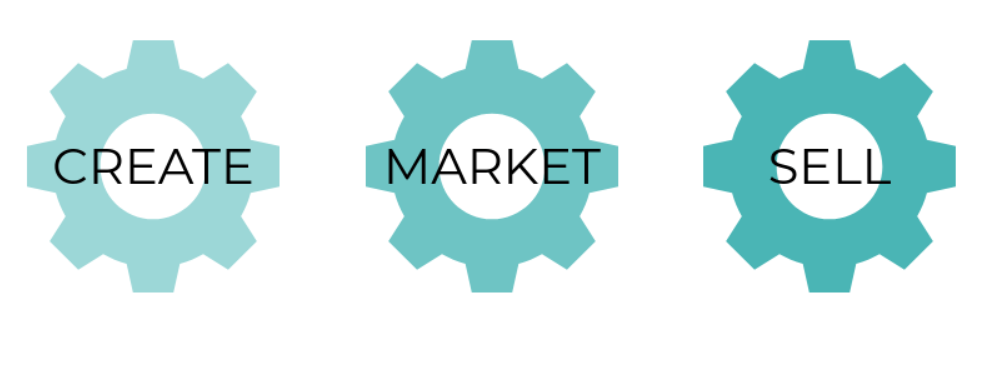
They don’t spin independently; each depends on the other to keep spinning.

And if one stops, the other two stop spinning as well.
You can’t just create a fantastic product and expect it to sell; people need to know about it (market) and be able to purchase it (sell).
You can’t market unless you have something to promote; you must first create a product and have a place where people can buy it.
Therefore, if you don’t have a product to sell, you can’t build a website or set it up at a craft show (create). And you can’t sell to anyone if you don’t use marketing to bring people to your website or craft show booth.
Each step/gear is dependent on the previous one. So, in order to attract more customers, we must examine each aspect of your business: creation, marketing, and sale.
HOW CAN YOU GET MORE CUSTOMERS?
We’ll look at three things that must be in place for someone to buy.
Then we’ll examine how each factor affects each step of the process (create, market, sell).
FIRST BUYING FACTOR: THEY LIKE WHAT THEY SEE
People will not buy from a company they dislike…
Unless they are forced to because that business is their only option (which is not the case here).
We don’t create products, social media posts, websites, or craft show booths that we believe people will dislike.
However, the reality is that not everyone will appreciate your work.
Your products will never appeal to everyone.
Nothing you post on Facebook will ever be of interest to everyone.
Your Etsy shop or craft show booth design will never please everyone.
And the disadvantage of attempting to please everyone is that it results in pleasing no one.
When you get specific and aim to please a specific type of customer, they are more likely to like what they see and pay attention to your marketing, visit your online or offline store, and purchase multiple products.
SECOND BUYING FACTOR – THEY HAVE A REASON TO BUY
Consumers do not buy luxury products on a daily basis, which most handmade products are (luxury meaning it is not a necessity, such as food).
So, even if we see amazing items every day, we don’t buy them unless we have a reason to.
That reason for purchase could be because:
Something fresh is required. Because:
- We have a new problem that needs to be resolved.
- We need a gift for a special occasion.
- We’ve run out of a product (for example, our favorite hand cream).
Want to try something new? Because:
- The season has changed.
- New trends are emerging.
- We have a special event coming up (for example, we’re throwing a party, going out on the weekend, dressing up for a wedding, etc.).
- We were just paid.
We believe we will miss out if we do not purchase now. Because:
- A limited-time sale may be taking place.
- A product has limited quantities and may sell out.
- We are trendsetters who want to be the first to adopt a new trend.
However, you must consider the specific customer you are attempting to reach and when they are likely to have a reason to purchase your products. Then you can apply that logic to the three areas of your company (create, market, sell).
Obviously, the reasons people buy change throughout the year. As a result, the products you offer, the marketing messages you use, and the products you sell must all be consistent with that reason.
Let’s look at how each step on the path to more customers (creation, marketing, and selling) can be addressed in terms of why consumers need/want to buy.
THIRD BUYING FACTOR – THEY ARE GLAD TO BE BUYING
Have you ever decided against purchasing something because the checkout line was too long or the customer service was poor?
Have you ever put something in your shopping cart but then wondered if it’s safe to enter your credit card number if your item will arrive on time, arrive at all, or look as good as it does in photos?
Cart abandonment is a serious issue, you guys. It ranges between 60% and 80%.
That means that 60% to 80% of people who add your products to their online shopping cart do not purchase!
Although those statistics apply to online shoppers, in-person shoppers are also considering purchases and can easily talk themselves out of them.
The following are the most common reasons why people change their minds about making a purchase:
- A lack of Faith
- Pricing
- Undecided
- Issues with the checkout
- Unexpected expenses
Let’s take a look at how you can help alleviate some of these concerns and keep your customers feeling good about their purchase decision.
Understanding who sets and enforces sales and marketing accountability
Knowing and agreeing on realistic annual revenue figures using the approved reporting structure for sales and marketing personnel.
A well-developed plan is required to track success.
Examples to Promote and Sell Crafts Online
Business events can be an effective tool in your marketing arsenal. Trade shows, exhibitions, and other events can be a great way to:
- Display your products and services
- Raise brand awareness
- Launching new products and services
- Explore partnership opportunities
- Networking with members of the industry
- Check out what your competitors are offering
- Generate new business leads
- Attract and convert customers
- You can attend as a visitor
- Set up a trade stand or booth as an exhibitor
- Organize and run your own event depending on your goals
These opportunities, however, will not be available to all businesses. Consider your industry and business situation before deciding to participate in an event.
- Investigate all possibilities.
- You can attend as a visitor
- Set up a trade stand or booth as an exhibitor
- Organize and run your own event
- Depending on your goals
These opportunities, however, will not be available to all businesses. Consider your industry and business situation before deciding to participate in an event. Research all options.
Examples:
The names of these promotional events are frequently used interchangeably, and the distinctions are not always clear, but it’s useful to have an idea of what type of event will help you target the right customers.
Trade fairs
Trade shows are organized events at which various businesses in the same industry display and demonstrate their products and services.
These Trade fairs are frequently business-to-business (B2B) events attended by companies in a particular market.
Visitors are typically industry representatives from companies, distributors, resellers, suppliers, and media.
Beauty, software, architecture, and medical trade shows are a few examples.
Exhibitions
Exhibitions are organized events that promote products and services in a specific category or topic (which may span across industries).
It may target B2B or B2C audiences, depending on the theme, but they frequently aim to attract the general public.
Food, travel, pet, computer, and camping-and-caravan expos are some examples.
Conferences
Conferences are formal, structured gatherings of professionals to exchange information and ideas on a specific topic. They typically include expert speakers.
However, B2B interaction is typically the focus of conferences.
They can: provide sponsorship opportunities; participate in networking; and provide training and development.
Accounting, engineering, marketing, and legal conferences are a few examples.
Sell Crafts Online by Using Drop Shipping
Dropshipping is a retail strategy in which brands do not manage and distribute their product inventories directly. Instead, when an order is received, the company sends information such as the product number, delivery address, and order date to a third party to fulfill the order on its behalf.
Benefits of Drop Shipping
Reduced startup costs
Businesses that use a dropshipping strategy save money by not investing in inventory or establishing a warehouse. They also save time by not having to organize their inventory or hire a staff to fulfill orders. Secondly, dropshipping has a low barrier to entry because you can start a dropshipping business even if you don’t have the funds to run a traditional retailing operation.
Scalability
Because order fulfillment is not dependent on the size of a physical location or the number of workers required to ship out an order, a dropshipping retailer can scale quickly. As a result, dropshipping can greatly benefit retailers who have fluctuating sales due to seasonal factors or other factors.
Inventory management is simplified
Dropshipping reduces the management overhead that retailers face by eliminating the need to maintain physical inventory. They are not required to track inventory, manage the infrastructure that houses it, or manage shipping, which is outsourced to suppliers.
A wide range of products
Dropshipping expands product possibilities. Retailers can offer a broader range of products, allowing a small business that would not be able to offer as many options without storage to sell a diverse range.
Flexibility
Many aspects of a retail business benefit from dropshipping. A brand can operate from anywhere, offer a variety of products, and easily change its offerings as market preferences shift.
As we all know India is the richest source of craft business in the world, here are some steps that the Indian government took to empower handicraft businesses:
Steps Were Taken by The Government to Boost Handicrafts
The following are the steps taken by the government to boost and strengthen the handicrafts sector, which includes handmade carpets, in order to compete with machine-made products:
- Market Development Assistance (MDA) Grant and Market Access Initiative (MAI) Assistance for Fairs and Exhibitions/Reverse/Buyer-Seller Meets in India and Abroad
- Through marketing and other schemes, the government provides assistance for marketing research, branding/international publicity, participation in fairs and exhibitions, buyer-seller meetings in India and abroad, and so on.
- Thematic display and live demo of sell crafts online by Master Craftspeople in international exhibitions.
- Promotion of Indian handicrafts’ brand image abroad through seminars, publicity, and awareness programs in India.
- Organizing an Indian Handicrafts and Gifts Fair twice a year, in addition to product-specific shows.
- Promotion of new designs through exporters to raise awareness and marketing.
- A Technological Upgradation Center has been established in Saharanpur to provide technical assistance to wooden crafts.
- Common Facility Centres have been established in Jodhpur and Saharanpur to assist manufacturers/exporters in developing new designs and finishing products.
- The International Lace Trade Centre has been approved in the Lace & Crocheted Crafts Cluster in Narasapur, Andhra Pradesh.
- Moradabad Resource Centre was established in Moradabad to facilitate information on business development, world market trends, marketing, and publicity, as well as to cater to the changing tastes and requirements of the international market and to keep up with the latest developments.
- Establishment of Mega Clusters in Bhadohi-Mirzapur and Srinagar to increase carpet manufacturing and exports.
- Providing financial assistance for the operation of Carpet Weaving Training Centers in the Bhadohi-Varanasi-Mirzapur areas in order to create new Artisans/Weavers with stipends.
- Excise and Customs Duties paid on imported inputs are refunded through the Duty Drawback channel.
- Establishment of the Indian Institute of Carpet Technology (IICT) in Bhadohi.
Conclusion
There has never been a better time to sell handmade items online. With the global demand for handmade goods increasing, it’s time to sell crafts online, open a shop, and start selling handicraft items. You will not only be able to earn money, but you will also be able to pursue your passion. This article provided fully-fledged information for selling your handcrafted items online.
Hopefully, you are now ready to embark on a new journey toward your dream. If you require assistance on your journey, please do not hesitate to contact us. We’re here to assist!


